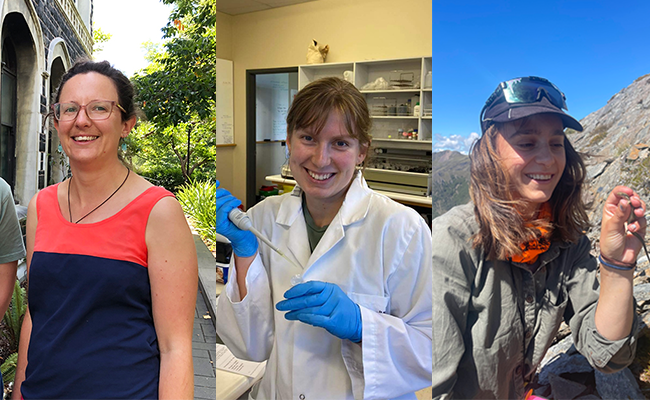
Scholarship winners are, from left, Nia Weinzweig, Iona Grigor and Anna Zrinyi-Morgan.
University of Otago master's candidates investigating parasites in sea lion poo, a rare skink found only in the Kahurangi National Park and how much oestrogen is polluting freshwater ways of Otago have recently received funding from annual scholarships.
Nia Weinzweig received $7500, and Anna Zrinyi-Morgan got $7,500 from the Department of Conservation, while Iona Grigor got $15,000 from the Environment Protection Authority.
Looking into local sea lion population
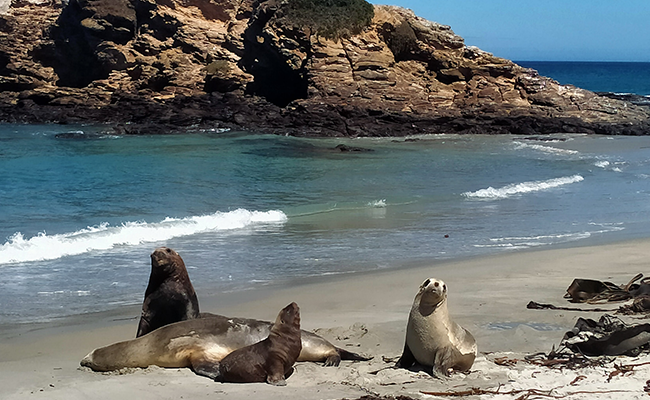
Nia wanted to make the most of the readily accessible population of sea lions near Ōtepoti.
Nia Weinzweig, who is completing her Master's in Science through Ecology, has spent the past year collecting faecal samples from sea lions along the coast of Ōtepoti Dunedin. It is a non-invasive technique which hasn't been used on this population of sea lions before and it allows her to examine what parasites they might have.
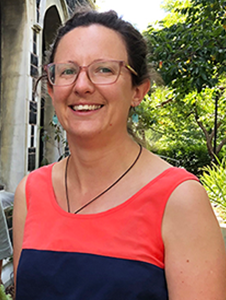
Masters candidate Nia Weinzweig
Other studies looking at different aspects of sea lion health require the sea lions to be sedated before blood samples could be taken, she says.
“So, ideally, finding out what we can learn from this non-invasive method and whether we can use it for ongoing surveillance as a sort of low cost, non-disruptive method of monitoring what's happening in the population.”
Sea lions born around Ōtepoti are tagged, as well as some born on Rakiura and subantarctic islands. Local tags are recorded on the New Zealand Sea lion Trust's database and all of the tags are on a database managed by DOC. This enables Weinzweig to identify the sea lions she is collecting samples from.
“Every single sample is attached to an individual.
“So, I either I see the poo happen and they move away and I pick it up or they're sleeping and I follow their tracks along a little way away, and if there's a poo, I'll collect that.”
A couple of years ago, just before COVID-19 lockdown, Weinzweig worked for DOC, spending 10 weeks on Campbell Island monitoring the sea lion colony.
“When I came back, I had sea lions on my mind and a lot of free time.”
She decided to take on a master's project that makes the most of the readily accessible sea lion population to see what kind of impact being so close to people has on them.
“Could there by anything from people, wastewater, or livestock and pets that could be impacting the sea lions, or even potentially the other way round?”
She hopes her research will determine what a normal pattern of parasites looks like within this population and find out if there are differences between demographic groups.
She would also like to find out if sea lions have any zoonotic parasites – parasites which can go between animals and humans.
How much oestrogen is polluting Otago's waterways
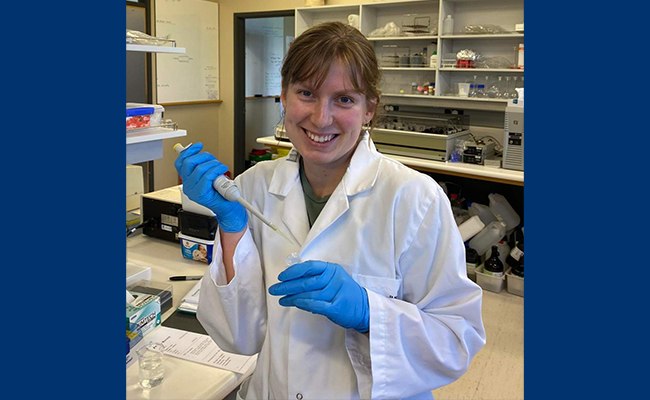
Masters candidate Iona Grigor says oestrogens in freshwater can have an affect on many species.
Iona Grigor says around the world and in different parts of Aotearoa New Zealand studies have been done on oestrogen as a pollutant, but not too much has been done in Otago.
Grigor's work is following on from work done by another Master's student, Danielle Turner, who was looking at oestrogens across Otago to get an overview of the region's situation. Grigor plans on investigating it a bit deeper.
Grigor, who is completing her Master's in science through the Zoology and Pharmacology/Toxicology Departments, is looking at samples of freshwater collected from streams and rivers by the Otago Regional Council to see if different oestrogens are present and in what quantity.
“If you've got oestrogens in the water that aren't supposed to be there, they can affect a whole range of different species,” she says.
Most vertebrate animals and some insects could be affected, and while oestrogen in water is not lethal it will change normal bodily processes within animals and insects, in particular reproduction processes which can result in a decrease in population.
It could potentially have a huge impact on native fish.
Oestrogen arrives in the water via a few pathways, she says, such as wastewater from humans, more so if a person is using oral contraceptives.
Plastic manufacturing and plastic pollution can also leak a range of chemicals which acts similarly to oestrogen, as can some pesticides, she says.
“Agriculture is another one as well. So if you've got like a whole bunch of dairy cattle or sheep in huge quantities in a small area, they produce a lot more oestrogens. Often their waste just goes onto the land and then washes off into waterways.
“I'm hoping to have a wide representation of the entire Otago region, and different sites – urban sites, different agricultural sites.”
The money from EPA will be useful, Grigor says, but in addition to funding the organisation is providing her with a lot of expert knowledge, putting her in touch with members of its team, all of which is “incredible”.
Researching rare alpine skink
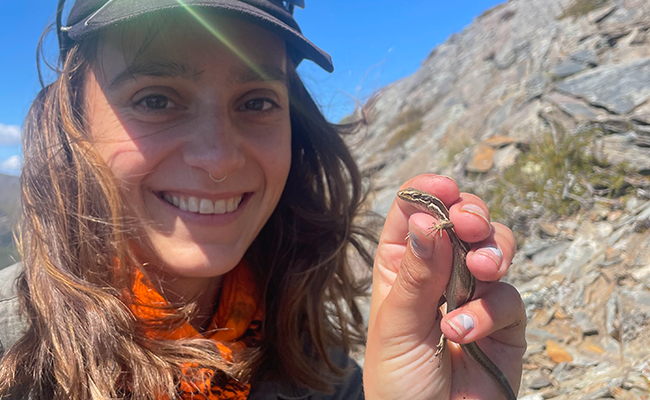
Masters candidate Anna Zrinyi-Morgan wants to know if the Kahurangi skink population could have once been more widespread.
The Kahurangi skink was found for the first time in the Kahurangi National Park, at the top of Te Waipounamu, in 2017. Since then only one scientific paper has been published on their taxonomic description. Anna Zrinyi-Morgan is the first to use specific field methods to try and understand more about their ecology.
“There's not a lot known about alpine skink species anyway, but there's even less known about the Kahurangi skinks. Their closest relative is in the Nelson Lakes National Park, which is about 120 kilometres away.”
Any information she can gain on them will be useful.
The Kahurangi skinks habitate two sites within Kahurangi National Park, and both sites are “quite remote and completely alpine”.
One of the biggest questions she hopes to answer is could the species have once been more widespread.
“I'm trying to understand, using a few field methods, what type of habitat they do use, and what do they spend the most time in.”
Zriyni-Morgan, who is doing her Master's in Science through Ecology, first got involved with conservation work as a volunteer when she was in high school and during her summer holidays while at University. Once she finished her Bachelors degree, she did some work experience with DOC.
“It kind of like opened my eyes to, like, the lizard world.”
It was then she realised she wanted to do postgraduate study in something related to conservation, and to give back to the places which had taught her outdoor skills.
In 2021 Kahurangi skinks were considered nationally critical, since then, a second population of skinks has been found.
“Hopefully, during my surveying, I might be able to find another population. That would be awesome.
Finding another population would help lower the threat classification.
“I will just have to see how the rest of the field season goes and what I find.”
Zrinyi-Morgan is doing her Master's in Science through Ecology.
The DOC scholarship is “super helpful”.
“There's quite a few costs when doing long trips in the back country, even just keeping myself there for a week is a big cost. Just accessing the
Kahurangi at times can be really hard,” Zrinyi-Morgan says.
The scholarship had enabled her to purchase suitable equipment for remote, alpine conditions.
Student Eva De Jong also received a DOC scholarship for her research on the impact of different management strategies on native fish living in braided rivers but could not be reached for this story.
